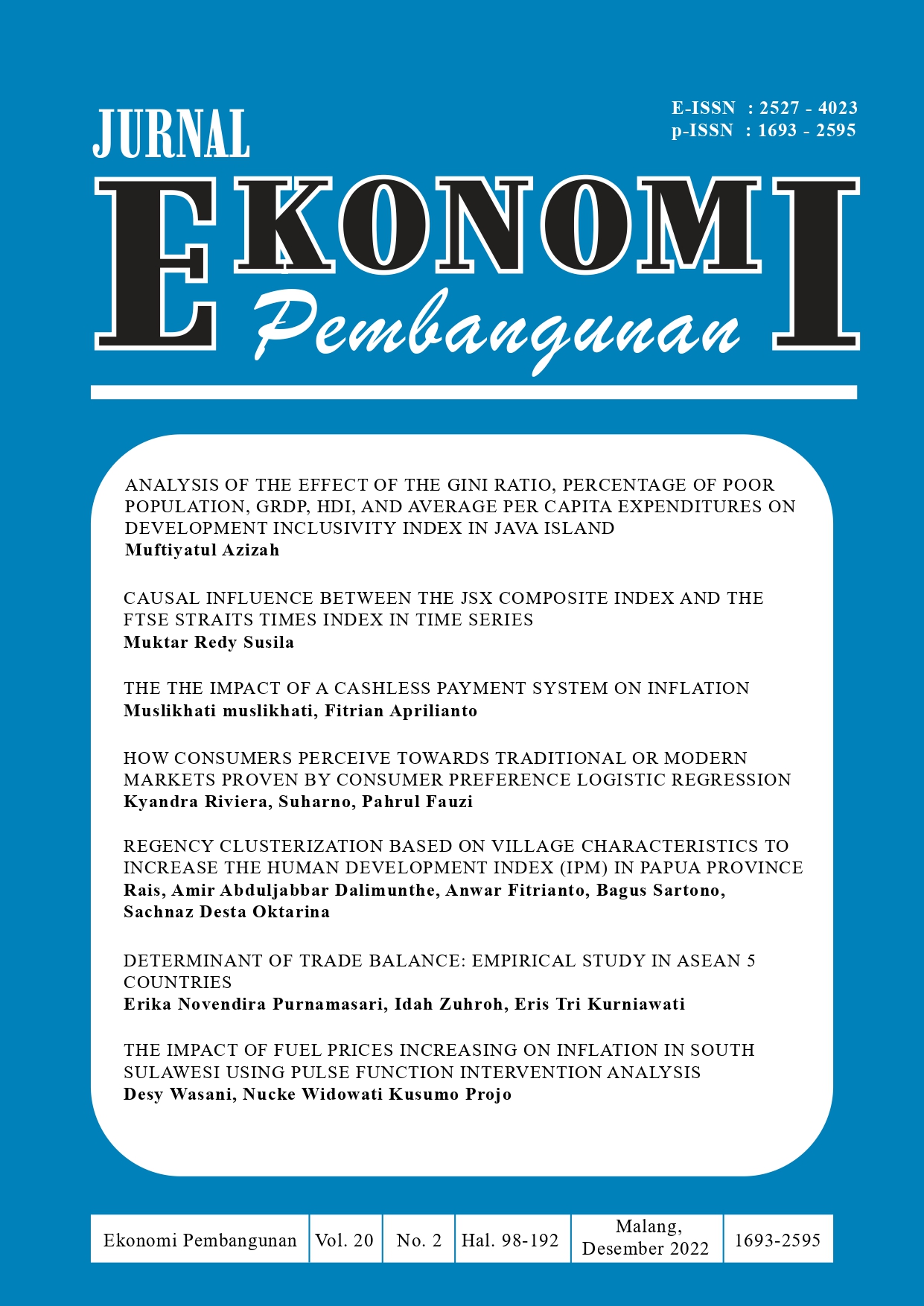Regency Clusterization Based on Village Characteristics to Increase the Human Development Index (IPM) in Papua Province
DOI:
https://doi.org/10.22219/jep.v21i02.22911Keywords:
cluster analysis, HDI, Industrialization, infrastructure, Urban, Rural, and Regional EconomicsAbstract
Inequality in the Human Development Index (IPM) in Papua Province amid the disbursement of development funds needs to be studied adequately so that the policies and programs that have been planned can be more directed and on target. For this reason, research is needed that can map the priority needs of each district in Papua Province by identifying regional characteristics, namely villages. By using Cluster Analysis and Factor Analysis, the results of this research show that 4 district clusters in Papua Province were formed with different priority focuses on increasing the HDI. The main focus of the district HDI improvement priorities in Papua Province is divided into three through factor analysis: the infrastructure-telecommunication factor, the sanitation-economic factor, and the health-education factor. Each cluster is generally still dominated by districts with a low HDI category. The main obstacle to increasing HDI in Papua Province is the transportation and telecommunications infrastructure factor. Local governments are expected to be able to formulate human development programs and policies concerning the priority needs of each district as a result of this research.
Downloads
References
Badan Pusat Statistik. (2019). Indeks Pembangunan Manusia 2018. Badan Pusat Statistik.
Hastie, T., Tibshirani, R., & Friedman, J. (2001). The Elements of Statistical Learning Data Mining, Inference, and Prediction.
Jiayi, X., Yifeng, G., Qidong, T., & Wendong, B. (2019). Project 2: KNN with Different Distance Metrics. https://bcmi.sjtu.edu.cn/home/niuli/teaching/2_2.pdf
Juliarini, A., & Hatmoko, A. W. (2020). Pengaruh Dana Otonomi Khusus Terhadap Indeks Pembangunan Manusia di Tanah Papua. In Simposium Nasional Keuangan Negara (pp. 335–355).
Kosim, N., Istiyani, N., & Komariyah, S. (2015). Faktor Yang Mempengaruhi Kualitas Hidup Penduduk Di Desa Sentul Kecamatan. Artikel Ilmiah Mahasiswa Universitas Jember.
Latuconsina, M. Y., & Zulfikar. (2017). Analisis Faktor-faktor yang Mempengaruhi Indeks Pembangunan Manusia Kabupaten Malang Berbasis Pendekatan Perwilayahan dan Regresi Panel. Journal of Regional and Rural Development Planning Juni, 2, 202–216.
Maulana, R., Pitoyo, A. J., & Alfana, M. A. F. (2022). Analisis Pengaruh Kemiskinan dan Kondisi Ekonomi Terhadap Indeks Pembangunan Manusia di Provinsi Jawa Tengah Tahun 2013-2017. Media Komunikasi Geografi, 23(1), 12–24. https://doi.org/10.23887/mkg.v23i1.39301
Purbantara, A., Mujianto, & Rahmawati, E. (2021). Pengembangan Daya Saing Produk Unggulan Desa dan Daerah Tertinggal Serta Transmigrasi. Jurnal Ilmiah Ekonomi Bisnis, 26(3), 278–292. https://doi.org/10.35760/eb.2021.v26i3.3666
Purwaningsih, F., Suharno, S., & Ahmad, A. A. (2021). Analisis Pengaruh Sanitasi dan Akses Air Bersih Terhadap Indeks Pembangunan Manusia di Jawa Tengah. Jurnal Ilmiah Universitas Batanghari Jambi, 21(1), 56. https://doi.org/10.33087/jiubj.v21i1.1210
Putra, E. D., & Pratiwi, M. C. Y. (2019). Identification of Leading Sector and Cluster Analysis of Regencies in Kalimantan. Economics Development Analysis Journal, 8(2), 224–243. https://doi.org/10.15294/EDAJ.V8I2.27237
Rimawan, M., & Aryani, F. (2019). Pengaruh Alokasi Dana Desa Terhadap Pertumbuhan Ekonomi, Indeks Pembangunan Manusia Serta Kemiskinan di Kabupaten Bima. Jurnal Ilmiah Akuntansi Dan Humanika, 9(3).
Sapkota, J. B. (2014). Access to Infrastructure and Human Development: Cross-Country Evidence.
Shrestha, N. (2021). Factor Analysis as a Tool for Survey Analysis. American Journal of Applied Mathematics and Statistics, 9(1), 4–11. https://doi.org/10.12691/ajams-9-1-2
UNDP. (1990). Human development report 1990. Oxford University Press for the U.N.D.P.
World Bank, & Australian Indonesia Partnership. (2009). Berinvestasi Untuk Masa Depan Papua dan papua Barat : Infrastruktur Untuk Pembangunan Yang Berkelanjutan. www.worldbank.org
Downloads
Published
Issue
Section
License
Copyright (c) 2022 Rais,Amir Abduljabbar Dalimunthe,Anwar Fitrianto,Bagus Sartono,Sachnaz Desta Oktarina

This work is licensed under a Creative Commons Attribution-NonCommercial-ShareAlike 4.0 International License.
Authors who publish with Jurnal Ekonomi Pembangunan (JEP) agree to the following terms:
- For all articles published in Jurnal Ekonomi Pembangunan (JEP), copyright is retained by the authors. Authors permit the publisher to announce the work with conditions. When the manuscript is accepted for publication, the authors agree to the publishing right's automatic transfer to the publisher.
- Authors retain copyright and grant the journal right of first publication with the work simultaneously licensed under a Creative Commons Attribution-NonCommercial-ShareAlike 4.0 International License that allows others to share the work with an acknowledgment of the work's authorship and initial publication in this journal.
- Authors can enter into separate, additional contractual arrangements for the non-exclusive distribution of the journal's published version of the work (e.g., post it to an institutional repository or publish it in a book), with an acknowledgment of its initial publication in this journal.
- Authors are permitted and encouraged to post their work online (e.g., in institutional repositories or on their website) before and during the submission process, as it can lead to productive exchanges and earlier and greater citation of published work (See The Effect of Open Access).

This work is licensed under a Creative Commons Attribution-NonCommercial-ShareAlike 4.0 International License.






















